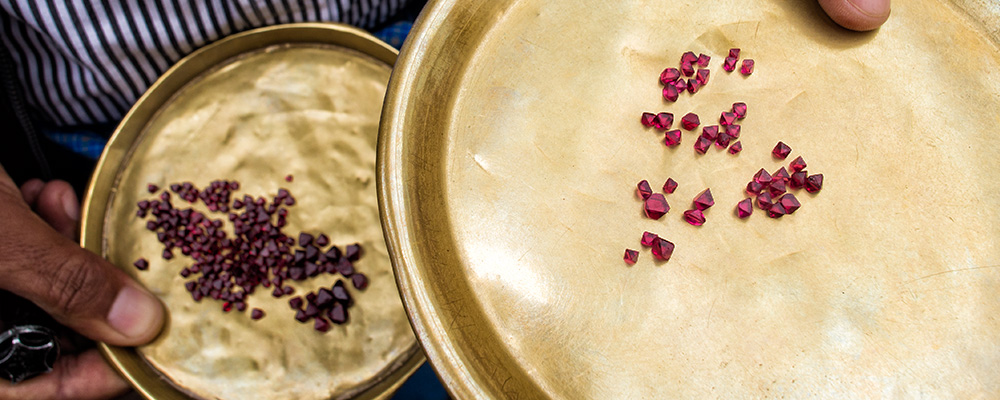Since the turn of the millennium, the price of fine spinel has risen at an incredible pace. No longer simply the poor man's ruby, spinel is finally getting the attention it deserves as one of the world's premier gems.
Introduction to Spinel • A classic gem
Spinel is rising. Like a phoenix, a gem that for centuries was associated with power, fire, beauty and life, is back again.
Over the past several years, interest in spinel has grown and I am delighted to see the newfound fame for classic gem. I first became interested in gemology while studying the history of the 100 Years’ War between France and England. Who could forget the Black Prince’s Ruby, a stone given by the Spanish king to the Black Prince of England as payment for his military support in the civil war of 1366. Later, in 1415, the stone was said to have saved the life of King Henry V of England at the battle of Agincourt. Henry, who had placed the large red orb on his helmet, was struck by the battle axe of the French Duke of Alencon. Sword hit stone; both the ruby and Henry survived.
If these stories were not already amazing enough, imagine a costly military campaign paid for entirely with a single gemstone. These are the legends of the Black Prince’s Ruby. But my greatest astonishment was learning that that the gem was not a ruby at all but, in fact, a red spinel.
Since I had no idea what a spinel was, I decided to learn more about this mysterious gem. Thus began my interest in gemology.
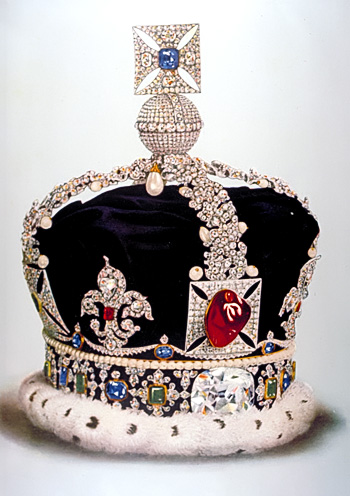
The Black Prince's Ruby. Illustration from Younghusband & Davenport (1919).
The gemology of spinel is a pleasure. Unlike ruby, there are few treatments and separation from both synthetics and simulants is straightforward. Nevertheless spinel is a rich subject, with a history nearly as long as ruby itself. The past fame, disgrace and recent resurrection of the gem are a lesson in the importance of nomenclature in marketing. Since gemology is truly a human science—mixing science, history, geography, art, trade and terminology—we must understand that human emotion is a crucial factor in marketing. Gems, even if rare and beautiful, also need a good name, and spinel is a classic example of that fact.

Namya spinel. Photo: V. Pardieu, 2006
The ashes of injustice
An interesting introduction about the geology and genesis of gem corundum deposits is found in Giuliani et al. in Geology of Gem Deposits (Groat, 2007):
The term “ruby” derives from the Latin word ruber. In Sanskrit, it was called ratnaraj—queen of the precious stones and symbol of permanent eternal fire. In Greco Roman times, the reference to fire was common; in 400 BC Theophrastus related ruby to Anthrax (coal). Two thousand years ago Pliny called all red stones carbunculus (diminutive of carbo) which became escarboucle in old French. In the eleventh century Marbode separated “three times” three types of carbuncles that correspond to the three hues known for ruby (from Myanmar, Thailand and Sri Lanka), red spinel (balas, ruby balas and pleonaste) and red garnet (pyrope, almandine and spessartine).
This introduction explains that the stones known in modern gemology as ruby, spinel and garnet were, for most of human history, simply sold as “red stones;” nevertheless, people were able to separate these red gems based on their obviously different appearances. Prior to the development of mineralogy and chemistry, color, appearance and origin were the traditional and common way to describe and identify gemstones: Thus the famous Balas ruby, under which the modern spinel was classified, probably referred to a “red stone from Badakhshan.”
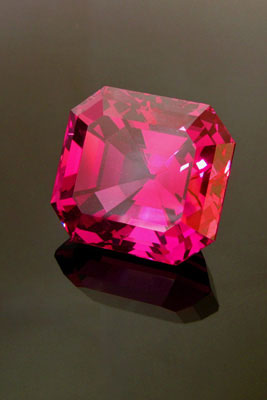
Exceptional large Tajik spinel weighing over 25 carats.
The origin of the word spinel is unclear. Spinelle was accepted by the French Academy of Science in 1762, possibly coming from the Italian spinello, meaning “joint” (Deville, 2002) or spina, meaning “thorn” (Webster, 1994). As mineralogical analysis moved forward, the use of the word “ruby” was restricted to the red varieties of gem-quality corundum (trigonal Al2O3), while spinel and garnet were used for “rubies” of different mineral types.
Applying the term “spinel” to a gem that had previously been a “ruby” was a disaster from which the gem has only today begun to recover. In older gemological books, we can read marketing death sentences like:
The color of spinel often resembles that of the ruby, but in all other characters the two minerals are perfectly distinct, so that the names ruby-spinel and balas ruby, which are sometimes given to certain color varieties of spinel are misleading and incorrect.
Max Bauer, 1904
The irony is that in the description of rubies in gemological publications we find references to famous rubies like the Black Prince’s Ruby and the Timur Ruby with not a mention that that these rubies are actually spinels. In Corindon et Spinelle, the authors recognize this irony, relating that “if spinel is not well known in Europe as a gem, red spinel used as ‘ruby’ is present in many pieces of royal jewelry.”(Cresbon et al., 2002).
What does this mean? It shows that red spinel was appreciated for centuries as among the most valuable of gems, a stone precious enough to be collected by kings. There is more than a little irony in the fact that the vast majority of famous “rubies” are actually red spinels; true rubies are rare. Thanks to these famous spinels, Europeans became familiar with “ruby.” And some 200 years ago, when European mineralogists learned to separate ruby from spinel, the seeds of a great injustice were sown.
What's in a name?
The main problem spinel faced during the past two centuries was the lack of name recognition. Centuries of promotion and marketing all went to ruby. Sadly, even though spinels were among famous European treasures where they were still described to the public as “ruby,” with the exception of a small group of connoisseurs, spinels dropped from sight.
Once a clear distinction was made between ruby and spinel, demand for spinel was suddenly lacking, resulting in declining prices and poor consumer awareness. By the end of the 20th century, spinel had become, at best, a collector stone or, at worst, a cheap alternative for ruby.
On the other hand, the equation between supply and demand for rubies was probably the opposite: fine large rubies suddenly became even rarer, but public recognition of the ruby name was great. It may explain the colonial appetites of the French and English empires for the Mogok ruby mines during the 1880s which resulted in the creation of the “Burma Ruby Mines Limited” in 1888 and its successful introduction on the London Stock Exchange in 1889.
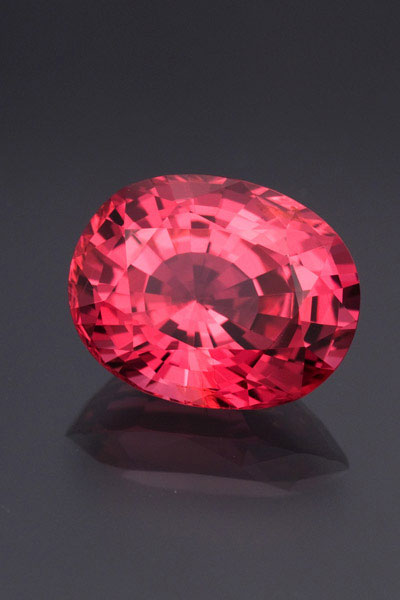
Fine Vietnamese red spinel. Stone courtesy of Pala International. Photo: Wimon Manorotkul.
Reports about the fabulous ruby treasures of the king of Burma, the British conquest of Burma, and the arrival of the Burmese army in Mogok provided serious promotion for ruby, but nothing for spinel. But few saw the large fabulous gems they dreamed about, as most large rubies like the famous Nga Mauk of the Burmese king disappeared after the British army took Mandalay in 1888. The whereabouts of these large rubies of the Burmese king are unknown and some wonder if they ever existed.
The book Ruby & Sapphire (Hughes, 1997) details the deep historical and gemological relation between red spinel and ruby. Hughes says that large fine rubies were and are still extremely rare, one of the reasons being that most of the large historic rubies became spinels when the terminology was revised. He also points out that the only important historic source for rubies until the 20th century was Burma.
An additional factor explaining the rarity of large fine Burmese rubies is also discussed. For many centuries in Burma all the large rubies were de facto the property of the Burmese kings. Stories do exist of Burmese miners breaking up large stones into smaller stones in order to be able to sell them instead of giving them to the king. The famous Nga Mauk ruby and the fate of the miner who found it is a good illustration of this theory.
As a result, many large rubies were possibly lost forever while the large rubies that could escape that fate and were collected by the Burmese king disappeared when the British army took Mandalay. The stones were apparently broken or recut to be sold. As a result, when we study the list of confirmed known large beautiful faceted unheated rubies over twenty carats, it is extremely short.
During the last thirty years, as demand for such stones has increased, several large and fine stones have appeared in the market, but the transparency and beauty of these exceptional gems is partly the result of heat treatment. The reasons for the high market value of rubies are the combination of high demand and a very limited supply. This high demand is driven by the stone’s beauty and durability, but also by the incredible public recognition of the word “ruby.” Thanks, probably, in large part to the stones that are today called “spinels.”
Spinel: A modern beauty
In today’s world, where few can afford a large ruby or a pink diamond, where the taste for beauty is greatly influenced by diamond marketing, where ruby is struggling with treatment controversies, spinel is making a noticeable return, and this could be the possible start of a true resurrection. The lack of public recognition of spinel means that a beautiful large gem is still much more affordable than a ruby or a diamond of equivalent size and beauty. Thus weakness can possibly become an advantage.
In an age of ecological awareness, a gem whose beauty is entirely from nature can have a significant advantage over a treated stone. As public recognition of spinel is growing, I believe that spinel, as the phoenix (an Asian symbol for beauty and females and a western symbol of immortality, fire, resurrection and divinity) could be reborn from the ashes of injustice. If ruby is the king of the gemstones, if diamonds are eternal, spinel is truly, at least for me, the phoenix gem.
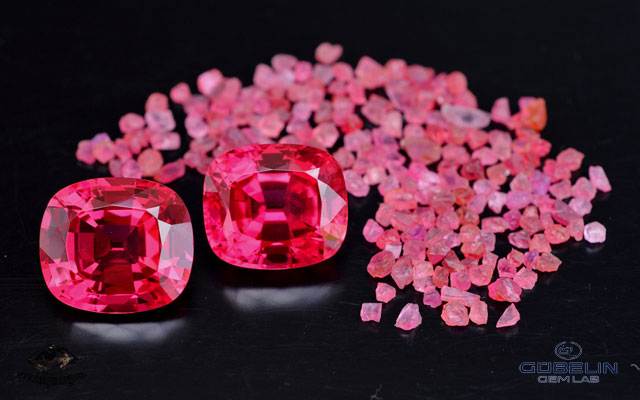
Fine red spinels from Mahenge, Tanzania. These fabulous gemstones (over 20 carats each) were cut from one of the giant crystals found in August 2007 at Ipanko. Stones courtesy of Paul Wild, Idar-Oberstein. Photo: V. Pardieu/Gübelin Gem Lab 2008.
It is probably foolish to compare one gem with another, but let me try. Regarding beauty, there is no question that red spinel does not hold its color under fluorescent lighting as well as ruby. Nevertheless, in natural or incandescent light, fine red spinels simply look gorgeous.
Spinel’s second traditional weakness compared to ruby is that its saturation is usually weaker. For this reason, “balas rubies” were in the past seen as “feminine” rubies: spinels, with the noticeable exception of some highly fluorescent spinels from the Namya deposit in Burma, are usually more pastel than rubies of equivalent hue and tone. With a colder beauty compared to ruby, spinel is nevertheless benefiting from the fact that the diamond industry has, during the last century, done a lot for the promotion of “cold beauty” and the pastel colors of colored diamonds.
Spinel can be truly seen as a modern gemstone as many aspects of the beauty of spinels are in the line with the tremendous marketing efforts that were carried out by the diamond industry. The influence of diamonds in the modern taste for beauty is obvious: nowadays gems have to be faceted, be highly transparent, and sparkle with an excellent cut and symmetry. Rubies do not entirely fit with this new trend.
Large spinels, being less expensive than rubies, are also usually better cut, as weight retention is less an issue. With a hardness of eight on Mohs’ Scale, they also achieve an excellent polish and spinel’s durability enables it to be used in all types of jewelry.
Like diamond, spinel is also singly refractive. The best spinels have a wonderful transparency difficult to find with doubly refractive stones like rubies (which are also usually included and silky).
The combination of good cut and polish, high transparency and attractive color makes large, clean spinels truly beautiful and lively sparkling gems which will perfectly fit the modern taste for beauty in colored gemstones. Red spinel also has another interesting advantage: diversity. Red spinels are today found in four localities around the world, each of which produces stones with slightly different colors and transparency.
Sources of red spinels
Tajikistan
Spinels and rubies are found in the same mining areas, with one important exception; Kuh-i-Lal, the traditional historical source of spinels, where no ruby is found. The Kuh-i-Lal mines (known in the gemological literature as the ‘Badakhshan ruby mines’) are located in what is today Tajikistan. During much of the 20th century, little was known about these mines due to their geographical situation in a closed area of the then-Soviet Union.
Said to have been discovered following a 7th century earthquake, the Kuh-i-Lal mines were the world’s main sources for large spinels for centuries. Located on the famous Silk Road that linked Europe with Asia, these mines probably produced the Black Prince’s Ruby, the Timur Ruby and other large spinels from the Persian, Russian, Mughal and European treasuries. The mines fell under the control of Imperial Russia at the time of the “Great Game,” when Russian and British colonial appetites created the map of Central Asia with Afghanistan as a buffer state between Russia and British India. As the Soviet Union had no real interest for gems and jewelry, the exact location of these ancient mines, located on the Russia-Afghanistan border, was long a mystery to the outside world.
Following the collapse of the Soviet empire and the end of the ensuing Tajik civil war, spinel mining was ramped up. In 2005 and 2006, several gemologists visited and reported about these historic mines (Bowersox, 2005; Hughes & Pardieu et al., 2006).
Most Kuh-i-Lal spinels tend towards pink. But as with all lighter-toned stones, color builds with size. The explanation is simple optics: as the light path becomes longer inside the gem, the color becomes more saturated. Recently large red spinels have again been reported from the famous Kuh-i-Lal mines of Tajikistan. These are said to closely resemble the gems of yore, those royal spinels that made the name “ruby” a household word.

Vince Pardieu, Kuh-i-Lal village and the Panj river (the natural border between Afghanistan and Tajikistan) as seen from the historic spinel mines. Photo: G. Soubiraa, 2006.
Myanmar (Burma)
During most of the 20th century, interest in spinel was minimal. The main spinel mining area was then Mogok,
the “ruby land” of the former Burmese kings. Mined in Mogok, red spinel was for years seen as a by-product of ruby mining, a cheaper alternative to ruby.
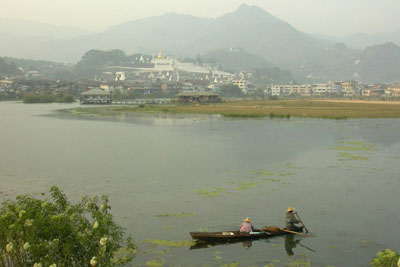
A view of Mogok, its lake (a former gem mine) and pagoda-covered mountains. Photo V. Pardieu, 2004.
Mogok, Myanmar
I visited the Mogok valley, the famous "ruby land," four times from 2001 to 2004. It was the main world source for red spinels in the 20th century. In Mogok, red and pink spinels can be found in both primary and secondary deposits throughout this beautiful pagoda-studded mountainous region. At the time of my visits, the most productive spinel mines were near Pein Pyit village in the eastern part of the Mogok Stone Tract. The area produces spinels both from primary deposits in marbles (associated commonly with chondrodite, mica and blue apatite)
Mogok red spinels can be found in many hues, tones and saturations from the lightest pink through orangy red (called flame spinels) and purplish red to pure red (sometimes called in the past ruby spinels). The fine intense red spinels are called in Burmese anyant pan. For many years, as the interest in spinel was weak, the main quality factor for Mogok spinels was to look like rubies, meaning to have a high red saturation. Such stones are still appreciated in traditional markets such as Geneva, in Switzerland.
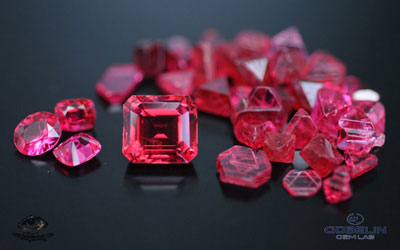
Fine Mogok red spinel (over 5 carats) with Mogok spinel crystals including "Star of David" macles. Photo: Vincent Pardieu/Gübelin Gem Lab, 2008.
Namya, Myanmar
As a gemology student in Burma in 2000, I lived with a Mogok spinel dealer. Thus I was perfectly situated to witness the growing interest in spinel, when a fabulous find was made at Namya (a.k.a. Namyazeik or Nanyazeik), a small village near the Hpakan jade mines in Burma’s Kachin state.
Richard Hughes had visited the area in 1996 and again in 1997, but there was little mining. In December 2000, thousands of miners descended on the scene following the discovery of stunning, hot pink spinels (see photo) and attractive rubies. In July 2001, with Hemi Englisher, an enthusiastic Thailand-based spinel dealer, and Ted Themelis, I was among the first foreigners to visit this deposit after its revival. It was my very first gemological expedition, a revelation for a future “travel-addicted gemologist.”
Production at Namya is irregular. The swampy mining area is difficult to work during the rainy season due to flooding and malaria. High season is November through April. Mining at Namya is similar to that seen in alluvial mining areas in Mogok.
During my second visit in 2002, about twenty companies were mining. Most of them were ethnic-based former insurgent groups, who negotiated peace deals with the Burmese military in exchange for economic advantages. Private Burmese companies and the Burmese military were also involved in mining. Several areas were also left to local Kachin farmers for mining during the dry season. During Richard Hughes’ September 2004 visit, mining was only a fraction of what had existed just a few years earlier.
Even though as many as a thousand people were involved in mining and trading during the 2002 high season, few fine Namya spinels reached the gem market. Nevertheless beautiful faceted stones up to ten carats were seen.
The supply of fine large-faceted red spinels was an issue for gem dealers interested in Mogok red spinels: bright gems, I use to call “Jedi Spinels” as a reference to Hollywood blockbuster Star Wars, were a true rarity. Large Mogok red spinels are often “on the dark side of the force,” as I used to say, meaning a bit too dark in tone. Due to the scarcity of fine material, the spinel market was being limited to the gemstone collectors/ connoisseurs and to the ruby simulant niche.
Even if red spinels are now found outside Burma, Mogok is currently the only known world source for small to medium size truly red spinels. In other spinel mining areas like Tajikistan, Tanzania, Vietnam, Sri Lanka or Madagascar, most of the spinels found in small size are pink to reddish pink, at best.
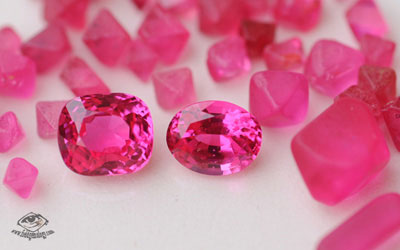
Hot pink spinels in rough and cut form from Namya, Burma. Photo: V. Pardieu, 2005.
Vietnam
In Vietnam, near Luc Yen, mining of rubies and spinels started seriously after 1990. Spinel mining was present when I visited the area in 2005 near Truc Lau and An Phu villages. These areas are beautiful and scenic with landscapes reminiscent of old Chinese paintings: white karst marble mountains surrounded by green rice fields and traditional villages. Spinels are found under the rice fields and in the marbles of the karst cliffs. Most of the Vietnamese production is composed of lovely and bright pastel-pink to pastel-purple gems. Very delicate pure “baby pink” gems can be found, and several gem dealers working with Vietnamese material referred to Luc Yen as a heaven of purity for pink spinels. Red spinels from Vietnam have been reported but they are so far truly rare.
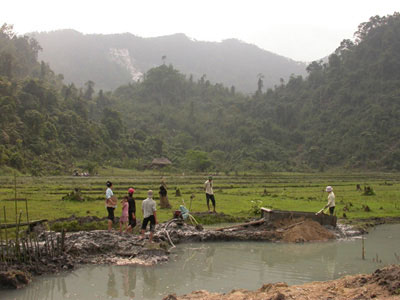
Spinel and ruby mining in rice fields near An Phu village, Luc Yen region, Vietnam. In the background are white marble cliff where spinels are also mined. Luc Yen Vietnam. Photo: V. Pardieu, 2005.
Tanzania
In Tanzania, spinels were found during the 1980s in marbles near Matombo and Mahenge, in Morogoro province. At that time, there was little market for the pinkish and often sleepy stones. When ruby mining in Morogoro declined, miners moved to Songea and Tunduru. When farmers found fine spinels at Ipanko near Mahenge in 2000, work began anew and soon the Mahenge region had more miners involved in spinel than ruby mining.
While many Mahenge spinels are of the pinkish, sleepy type, fine transparent reddish-pink stones are also regularly found from the Ipanko marbles and the nearby secondary deposits. In August 2007, the discovery of four huge spinel crystals weighing from six to fifty-four kilos brought spinel fever to Tanzania. These giant spinel crystals were opaque in their center, but gem-quality transparent material was found near the outside. Several exceptional highly transparent red spinels from 10 to 50 carats were reported to have been faceted from these areas; some of these stones were among the most spoken about gems seen at the Baselworld 2008 gem show in Switzerland. Spinel was back in force.
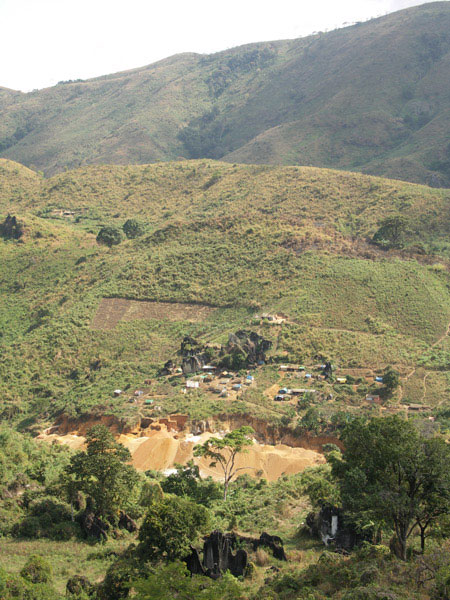
View over the Ipanko spinel mines near Mahenge, Tanzania and the exact location where the giant spinel crystals were found in August 2007. Photo: V. Pardieu, 2005.
A few weeks after the discovery of these giant crystals, VP and RWH visited the Mahenge mines. Several days after our visit, spinel mining at Ipanko was reported to have nearly stopped due to disputes over mining rights. Currently the situation is in flux, but Tanzania is now seen as a potential spinel wonderland.
Other localities
Other smaller spinel deposits have been discovered at Malipo in China’s Yunnan Province at the end of the 1990s, and in the Tsavo region of southwestern Kenya during the 1980s. Pastel-colored spinels are also found in the mountains near Hunza in the north of Pakistan, and from alluvial deposits in Sri Lanka, Madagascar (Ilakaka) and Tanzania (Tunduru). Sri Lanka is one of the oldest sources for spinel, but fine red stones are rare.
Pretty in pink
During the first years of the 21st century, pink came into vogue, driven by celebrity gifts of pink diamonds. The result was extreme demand for bright pink gems, including pink sapphires and pink spinels.
It was a great chance for pink spinel. With the new pink wave, spinel mining became more profitable and thus more miners moved to spinel-producing areas. As production increased, conditions for the discovery of truly exceptional gems were then present.
This is a key point in understanding gem production: exceptional gems cannot be mined without lesser stones. But exceptional stones alone do not support mining. Indeed, in the rare event that a fine stone is found, the lucky man may actually leave the business with his profits.
In any mine, the majority of stones found are low in quality. As colored stone miners often lack capital, they need a regular income to finance mining. If miners cannot sell the lesser gems, mining is not profitable and few will take the risk. Thus gem mining requires a steady market for the lower qualities. That market creates the chance for exceptional stones to be unearthed.
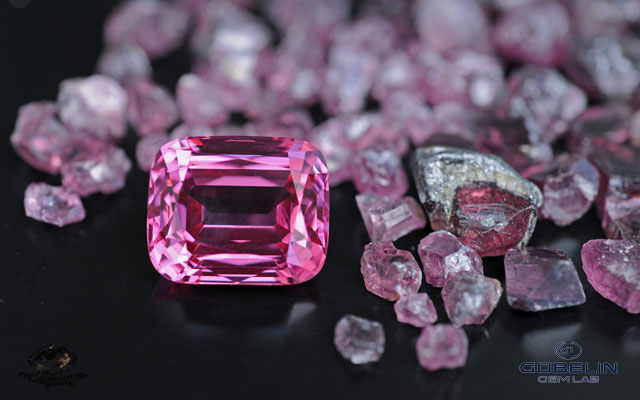
Fine Pamir spinel (over 20 carats) from Tajikistan, with rough spinels from the Kuh-i-Lal mines. Photo: Vincent Pardieu/Gübelin Gem Lab, 2008.
Phoenix rising
After nearly two centuries buried in the shadows of its former “ruby” alias, spinel is making a welcome return. Will this become a resurrection for this beautiful gem? Only time will tell. Nevertheless, the prognosis is good. With four major producing areas providing large clean and colorful gems, the supply problem will probably be less of an issue. New trends in jewelry like the pink wave suggest that spinel is on track to become one of the important gemstones of the coming century.
With such possibilities, long-term strategies with spinels are now a credible option for major gem dealers. This was noticed by several companies that started to invest and promote fine spinels. I would not be surprised if spinel continue its comeback.
On a visit to Tanzania in 2008, I was asked about the recent extreme price hikes for spinel: “Do you think spinel prices will continue to rise?” As a spinel lover, I say: “Why not?” This would be simple justice for a wonderful gem with a glorious past. With but a few notable exceptions, the great “rubies” of the past existed only in the words of the ancient texts. I relish the day when, once again, the great natural red stones might be beautiful red spinels. Spinel is rising.
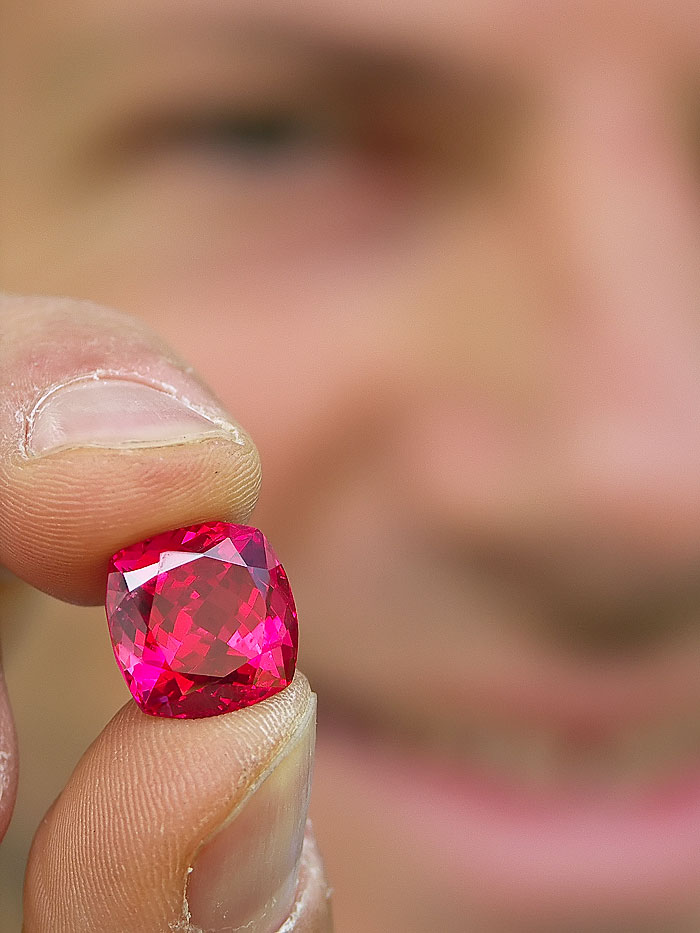
Eric Saul, ICA Ambassador to Tanzania, presenting a fine 12-carat red spinel cut from one of the giant Mahenge spinel crystals. Stone courtesy of Swala Gem Traders. Photo: V. Pardieu, 2007.

Acknowledgments
Special thanks to all the true spinel lovers, miners, dealers, gemologists or collectors who shared their knowledge and passion for this lovely gem.
References
- Bauer, M. (1904) Precious Stones. Trans. by Spencer, L.J., London, Charles Griffin and Co., First published in German in 1896; English edition reprinted in 1968 by Dover (2 Vols.) and 1969 by Charles E. Tuttle Co., 647 pp.
- Bowersox, G. (2005) July-August, 2005 Hindu Kush/Pamir Mountains Expedition.
- Bowersox, G.W. (1985) A status report on gemstones from Afghanistan. Gems & Gemology, Vol. 21, No. 4, pp. 192–204.
- Bowersox, G.W. and Chamberlin, B. (1995) Gemstones of Afghanistan. Tucson, AZ, Geoscience Press, xx, 172 pp.
- Cesbron, F., Lebrun, P. et al. (2002) Corindon et spinelles. Minéraux & Fossiles, Hors-Série No. 15, 105 pp.
- Deville, J. (2002) Corindon et spinelle dans l'histoire. In "Corindon et Spinelles." Minéraux & Fossiles, Hors-Série No. 15, Octobre, pp. 6–10.
- Groat, L.A., ed. (2007) Geology of Gem Deposits. Québec, Mineralogical Association of Canada, Short Course Series, Vol. 37, 270 pp.
- Hughes, R.W. (1994) The rubies and spinels of Afghanistan: A brief history. Journal of Gemmology, Vol. 24, No. 4, October, pp. 256–267.
- Hughes, R.W. (1997) Ruby & Sapphire. Boulder, CO, RWH Publishing, 512 pp.
- Hughes, R.W., Pardieu, V. et al. (2006) Moon over the Pamirs: Chasing ruby and spinel in Tajikistan. RWH Publishing.
- Kessel, J. (1955) La Vallée des Rubis. no city, Éditions Gallimard, reprinted 1994, Folio, France, 254 pp.
- Pardieu, (2005) Update on ruby and sapphire mining in Africa and South East Asia, Summer 2005, >http:// www.fieldgemology.org<
- Pardieu, (2006) From Kashmir to Pamir, Summer 2006, gemological expedition to ruby, emerald and spinel mining areas in Central Asia. Part 3: Tajikistan: gems from the Pamirs. Fieldgemology.org.
- Pardieu, (2007) Tanzania, October 2007, a gemological safari. Fieldgemology.org.
- Themelis, T (2000) Mogok, Valley of Rubies and Sapphires. A&T publishing, 270 pp.
- Themelis, T (2008) Gems and Mines of Mogok, 352 pp.
- Webster, R. (1994) Gems: Their Sources, Descriptions and Identification. Oxford, Butterworth-Heinemann, 5th ed. edited by P.G. Read, 1026 pp.
- Wise, R. (2003) Secrets of the Gem Trade, Brunswick House Press, Lenox, MA, 274 pp.
- Younghusband, G. and Davenport, C. (1919) The Crown Jewels of England. London, Cassell and Co., Ltd., 84 pp.
About the authors
Vincent Pardieu has held a number of positions in his gemological career. His writings and research can be found at www.fieldgemology.org and at the GIA's website.
Richard W. Hughes is one of the world’s foremost experts on ruby and sapphire. The author of several books and over 170 articles, his writings and photographs have appeared in a diverse range of publications, and he has received numerous industry awards. Co-winner of the 2004 Edward J. Gübelin Most Valuable Article Award from Gems & Gemology magazine, the following year he was awarded a Richard T. Liddicoat Journalism Award from the American Gem Society. In 2010, he received the Antonio C. Bonanno Award for Excellence in Gemology from the Accredited Gemologists Association. The Association Française de Gemmologie (AFG) in 2013 named Richard as one of the fifty most important figures that have shaped the history of gems since antiquity. In 2016, Richard was awarded a visiting professorship at Shanghai's Tongji University. 2017 saw the publication of Richard's Ruby & Sapphire: A Gemologist's Guide, arguably the most complete book ever published on a single gem species and the culmination of nearly four decades of work in gemology.
Edward Boehm is President of RareSource in Chatanooga, TN, specializing in fine, collectible, and exotic gems. He can be contacted through his website at www.raresource.com.
Notes
This article appeared in the ICA's InColor, Summer 2008, pp. 10–18.


